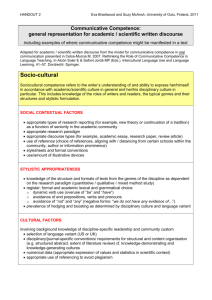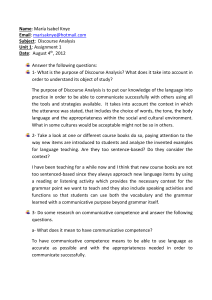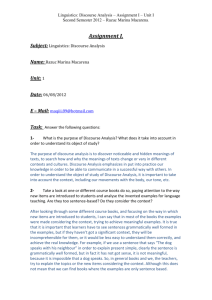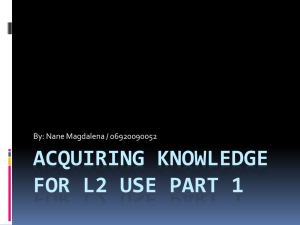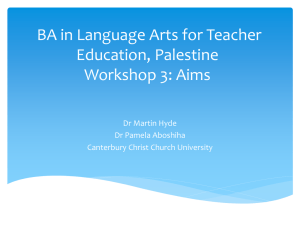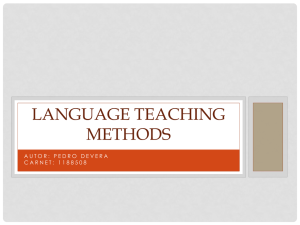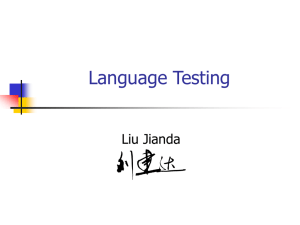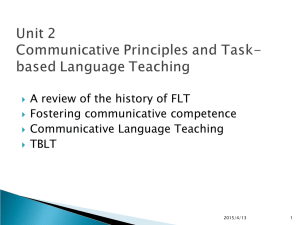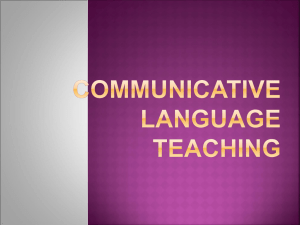Analysis of Students` Writing across the Disciplines: Planning
advertisement
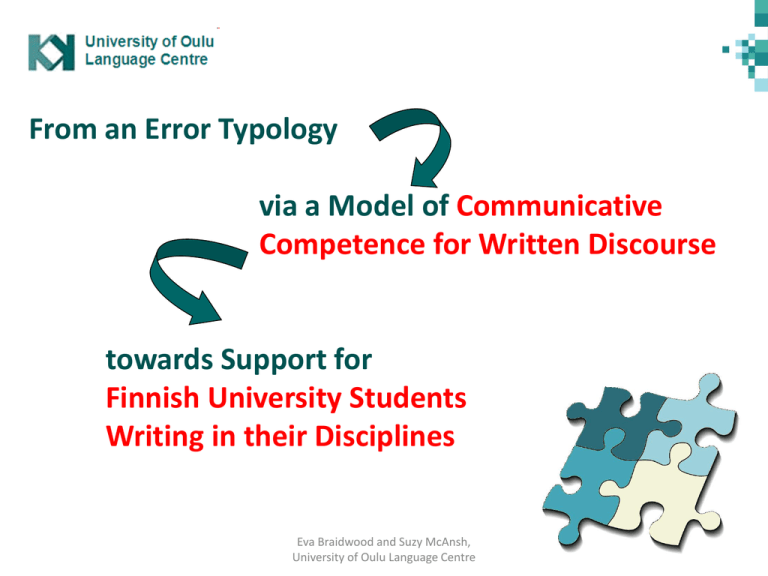
From an Error Typology via a Model of Communicative Competence for Written Discourse towards Support for Finnish University Students Writing in their Disciplines Eva Braidwood and Suzy McAnsh, University of Oulu Language Centre Assessing the situation: What factors shape our EAP courses in written communication? Policy frameworks and guidelines – qualifications frameworks in the EHEA – Finnish UniTIE project: descriptors for university writing courses State of the art in the EAP profession – research publications – numerous guidebooks into academic writing in English Students’ skills and needs – publications on SLA, error analysis – preliminary study of prevalent problems, 2010 Preliminary study of prevalent problems, 2010 Typology of salient problems – analysis of texts produced by Finnish university students in their field-related English course see Handout 1 for examples But what is missing? What else do we need to consider in assessing the writing of our EAP writing students? Present study: Towards a representation of communicative competence required in academic / scientific written discourse Eva Braidwood and Suzy McAnsh, University of Oulu Language Centre Chronological evolution of ‘communicative competence’ Expanded from Celce-Murcia 2007 Eva Braidwood and Suzy McAnsh, University of Oulu Language Centre competences for developing confidence in specialist discourse Celce-Murcia, 2007: Revised schematic representation of ‘communicative competence’ representing oral communication! PROBLEM: static model – components need to “expand or contract depending on pedagogical objectives and the needs of the learner” Proposed communicative competence model for academic / scientific written discourse • Six competence areas, but definition and component features differ in writing socio-cultural linguistic strategic • Significance of individual competences varies • At work simultaneously or in turn discourse interactional formulaic see Handout 2 for details Significance of present study – model encourages awareness of areas where problems might arise – provides tool for identifying and exploring prevalent problems • for a particular discourse (genre, purpose) • in a particular discourse community (context, discipline) – also accounts for problems that “aren’t there” – guides teachers in selecting focus of course content Future directions – explore implications of target degree competences in particular disciplines – compare students’ present level with target graduate level – expand study to identify prevalent problems for students (according to L1, disciplinary genres, level of proficiency in English, level of expertise in discipline-specific discourse community) Thank you! References Bachman, L. F. (1990). Fundamental considerations in language testing. Oxford: Oxford University Press. Bhatia, V. (1997). ‘Applied Genre Analysis and ESP’. In T. Miller (ed.), Functional Approaches to Written Text: Classroom Applications. Washington: United States Information Agency Canale, M. (1983). ‘ From communicative competence to communicative language pedagogy.’ In, J. C. Richards & R. W. Schmidt (eds), Language and communication. London: Longman, 2-28. Canale, M & Swain, M. (1980). ‘Theoretical Bases of Communicative Approaches to Second Language Teaching and Testing.’ Applied Linguistics, 1. 1-47. Celce-Murcia, M. (2007). ‘Rethinking the Role of Communicative Competence in Language Teaching.’ In Alcón Soler E & MP Safont Jordà (eds),. Intercultural Language Use and Language Learning. Dordrecht: Springer. 41–57. Celce-Murcia, M., Dörnyei, Z, and Thurrell, S. (1995). ‘A pedagogical framework for communicative competence: A Pedagogically motivated model with content specifications.’ Issues in Applied Linguistics, 6(2), 5–35 Eva Braidwood and Suzy McAnsh, University of Oulu Language Centre
